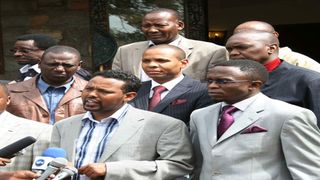
Chairman of the Parliamentary Select Committee on Constitutional Review Mohamed Abdikadir (centre) and other members of the committee after a meeting to discuss the draft constitution in Naivasha on March 1, 2010.
|Counties
Premium
How William Ruto, Uhuru Kenyatta helped to shape devolution
When Kenyans went to the ballot to endorse the new constitution on August 4, 2010, they agreed to have a two-level system—a national government and 47 county governments.
The path to the new system of governance was paved with political intrigues that involved a lot of horse-trading among politicians.
A key gathering that shaped the devolved structure was the famous two-week Naivasha retreat of the parliamentary select committee on constitution review. At the time, the debate on devolution was described by the committee members as “emotive”.
Devolution was seen by the MPs as an effective way of checking the national government, especially in resource allocation, but they also agreed that it should not take away the authority of MPs politically.
At the talks, ODM was forced to drop its quest for a three-tier system of national, regional and county governments as PNU insisted that the institutions created under the draft were too many and would be too costly. At the start of discussions, ODM had demanded that the PNU side reciprocate and support the three-tier system after the orange party dropped its earlier demand of a parliamentary system and supported the presidential system.
Ahead of the Naivasha talks, on November 17, 2009, the Committee of Experts (CoE) on Constitutional Review had published a harmonised draft constitution proposing three levels of government. This draft was put together after looking at all the previous documents including the draft compiled in 2002 by the Constitution of Kenya Review Commission (Ghai draft), the National Constitutional Conference of 2004 (Bomas draft) and the proposed constitution of 2005 (Wako draft).
Rejected
According to its January 8, 2010 report on the revised harmonised draft that accompanied the draft constitution given to the parliamentary committee, the CoE said that Kenyans had rejected the huge devolved government proposal. “In accordance with the majority’s preferences, the levels of government are reduced to two: national and county. This responds to concerns about the role of regional government and the cost of administration,” the report stated.
It added that for county government, the districts enacted in 1992 by the District and Provinces Act were provisionally adopted as proposed counties, bringing down the number of the devolved units from 74 to 47.
On January 26, 2010, in Naivasha, the select committee was tackling the Executive, Representation and Devolution chapters in the draft. Despite the proposal by CoE, committee members had the week before made a revision and agreed that there would be two levels of government—national and regional—with a total of 18 regions.
ODM reopened the matter with then deputy Prime Minister Musalia Mudavadi, asking the session to “discuss clarity on the agreed 18 regions”. Mr Mudavadi suggested that they pause discussions on how the devolved units would be funded and agree if what they were approving was about counties or regions.
ODM MPs, among them James Orengo (now Siaya governor) and William Ruto (now President) insisted that there had to be another tier below the regions. This debate went on into the night with the PNU side led by then Deputy Prime Minister Uhuru Kenyatta insisting that there should be only two levels.
With no resolution reached, at around 11.50pm, Mudavadi suggested they adjourn. After several hours of debate the following day, the committee members agreed to adopt the proposal by CoE because they could not agree on the number of the devolved units. ODM was still insisting that there should be 18 regions with 45 counties while PNU wanted 33 regions with no other level.
The insistence by both camps was purely about control based on the then political strongholds. PNU MPs saw themselves as the greatest losers if the initial proposal of eight regions and 74 counties was adopted. PNU would have had control of seven counties in Central, four in Nairobi and about eight of the 13 counties in Eastern. ODM, on the other hand, would have had 19 in Rift Valley, 12 in Nyanza, seven in Coast and eight in Western.
At the end of the retreat, the MPs agreed that the principle of devolution was necessary and proposed a two-tier system. They also agreed that there should be a Senate at national level and county assemblies.
The push and pull did not end in Naivasha as MPs sought to reopen the devolution debate when Parliament retreated to the Kenya Institute of Government (now Kenya School of Government) in March of 2010. ODM sprung a surprise by seeking to reintroduce the three-tier government. The matter was then left to CoE, which prepared a final draft aligned to the proposals made in Naivasha.
The next debate was on how devolved units would be funded.
So how did we come up with the “not less than 15 per cent” based on the “latest audited and approved accounts”?
According to the CoE report published on October 10, 2010, “the amount allocated to the county level of government must be at least 15% of the revenue raised by the national government in the previous financial year.” However, their own drafts never indicated this but instead based the 15 per cent on the “latest audited and approved accounts”.
The discussions in Naivasha indicate that Mr Kenyatta, the then Finance minister managed to convince his colleagues to retain the allocation at 15 per cent. He also asked MPs not to lock the figure, leaving room for flexibility.
According to the January 28, 2010 Hansard of the talks, Mr Kenyatta convinced the MPs to retain the proposal by CoE. He and Narc Kenya leader Martha Karua also led the MPs in adopting the reduction of the Equalisation Fund from 1 per cent to 0.5 per cent.
The ODM team at the talks was proposing that the amount be raised to 20 or 25 per cent. Former Senate Speaker Ekwe Ethuro and Mbita MP Millie Odhiambo backed them.
Debate, however, dwelt more on whether CDF would be part of the money that was to be devolved from the national government.
“... we should say not less than 20 per cent. You know CDF is not part of these counties. We get it from the national fund. Anyway, if that is the case, all I would want to do here is, provided that the 5 per cent for CDF is also locked in here,” Dr Ruto said.
The then committee chairman Abdikadir Mohammed however said that they should agree that CDF is part of the devolved funds and that whatever figure they agree on then it is deducted out of that.
In his contribution, Issac Ruto stated: “They are taking 15 per cent if it is not less than 20. Not less than 20 means you can give us 25 per cent. It depends on you. But if you are including CDF there then we go back to 25 per cent.”
According to the Hansard, Ruto told the meeting that he has received advice from the “DPM” (Mr Kenyatta) that the 15 per cent would be doubling the amount that was already going to Local Authorities Transfer Fund and CDF.
Advice
At this point, Abdikadir asked Uhuru to explain the advice which appeared to have “tempered” Ruto.
“If we can agree not less than 15 per cent and we have a clause that goes that: Not less than 15 per cent of revenue collection and to avoid, because that has been one of the big problems, to avoid the problems that we have had with CDF, we say calculated on the basis of the last audited accounts that have been approved by Parliament. The big problem here is if we do it on the basis the way we do CDF, we calculate on the basis of budget; if you do not hit targets and you have already committed the money you end up in a problem,” Mr Kenyatta explained.
Ms Karua said that since Parliament was the one to pass the Division of Revenue Bill, it would be free to push up the amount, if need be. She added that the 15 per cent was good enough for counties as there was a lot of work still to be handled by the national government.
After the explanations Dr Ruto said: “I think I am persuaded to accept 15 per cent. But they are consulting too loudly. Fifteen per cent is fine but we want to say that this money shall then be going direct to those counties because they have previously gone through the Ministry of Local Government; that 5 per cent, the actual amount that reaches down there has been 1 per cent. So, the Counties have been stuffed.”
TOMORROW: We break down the most important numbers and bring you what governors list as the miracles of devolution





